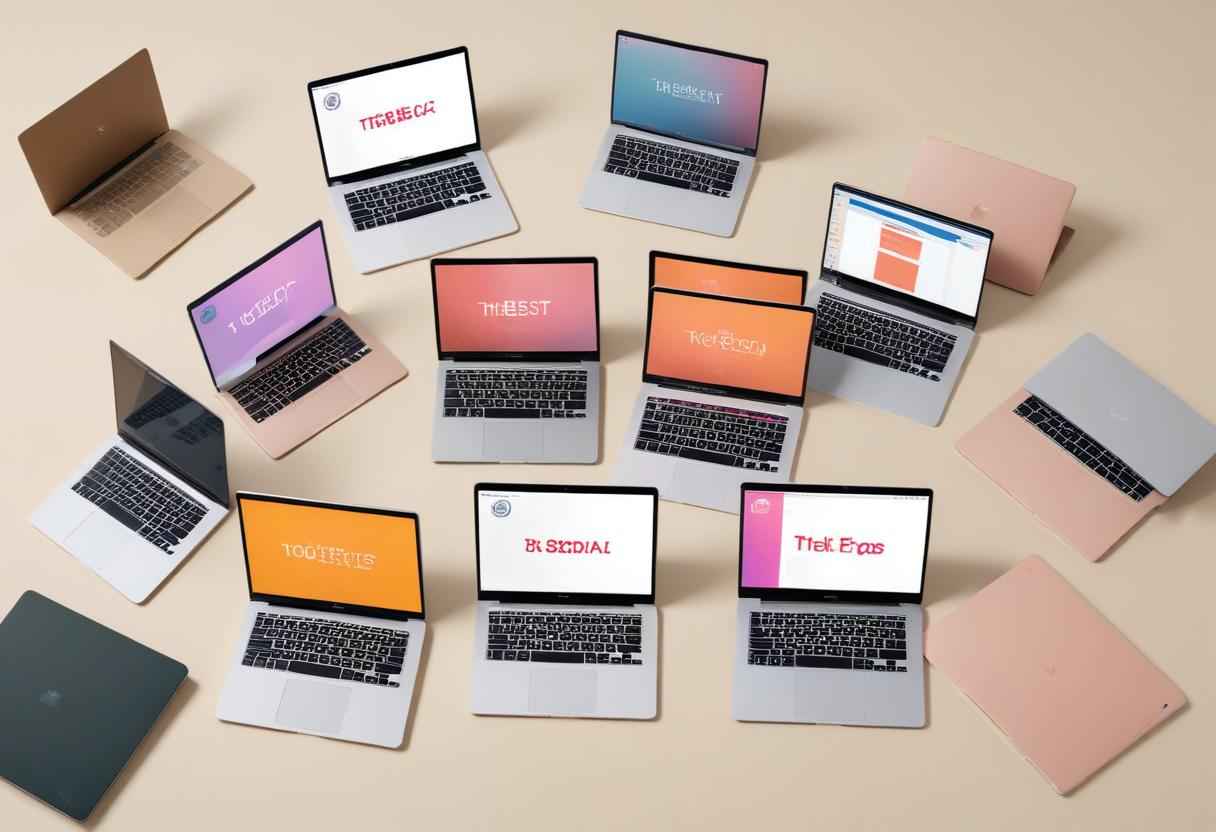As technology progresses, students require powerful and dependable laptops to support their academic endeavors. Whether taking notes, conducting research, working on projects, or browsing online, having the appropriate laptop can significantly impact performance, the marketplace will contain many choices, making selection difficult. This guide assists with top laptops available for students in 2024, highlighting features, strengths, and weaknesses.
Why Choosing the Correct Laptop Matters
Opting for the proper laptop holds importance for students for several reasons:
Ability: A quality laptop should efficiently handle educational software, streaming media, and more.
Portability: Students need lightweight, compact laptops that are easy to transport around campus.
Battery Endurance: All-day usage requires a long battery life without frequent charging interruptions.
Durability: A robust construction ensures withstanding daily wear and ensuring function.
Cost: Students regularly face budget constraints, so finding the best value becomes important.
Key Features to Consider When Choosing a Laptop
When selecting a laptop, students should focus on several key features to ensure they get the best device for their needs:
1. Processor
The processor, or CPU, is the brain of the laptop. A powerful processor ensures smooth multitasking and efficient performance. For 2024, look for laptops with the latest Intel or AMD processors, such as the Intel Core i5/i7 or AMD Ryzen 5/7 series.
2. RAM
Random Access Memory (RAM) impacts the ability to run multiple applications simultaneously. A minimum of 8GB RAM is recommended for basic tasks, while 16GB is ideal for more intensive activities like video editing or running virtual machines.
3. Storage
Solid-state State Drives (SSDs) offer faster boot times and data access compared to traditional Hard Disk Drives (HDDs). Look for laptops with at least 256GB SSD storage, with options to expand if needed.
4. Display
A high-quality display enhances the viewing experience. Full HD (1920 x 1080) is the standard, but 4K options provide even greater detail. Consider screen size and resolution based on personal preference and usage needs.
5. Battery Life
Long battery life is essential for students on the go. Aim for laptops that offer at least 10 hours of usage on a single charge to avoid frequent recharging.
6. Weight and Portability
Lightweight laptops are easier to carry around campus. A weight of under 3 pounds is ideal for portability without sacrificing performance.
7. Build Quality and Durability
Durability is crucial for withstanding daily use. Look for laptops with robust build quality and features like spill-resistant keyboards.
8. Connectivity and Ports
Ensure the laptop has sufficient ports for peripherals. USB-C, Thunderbolt, and HDMI ports are commonly needed for connecting external devices.
Top Laptops for Students in 2024
1. Apple MacBook Air (M2, 2024)
Specifications:
- Processor: Apple M2 chip
- RAM: 8GB (expandable to 16GB)
- Storage: 256GB SSD (expandable to 2TB)
- Display: 13.3-inch Retina display with True Tone
- Battery Life: Approximately 18 hours
- Weight: 2.8 pounds
Strengths:
- Outstanding performance from the M2 chip.
- Superb battery endurance.
- High-resolution Retina display.
- Light for transport.
Weaknesses:
- Higher expense.
- Limited ports (only two Thunderbolt 3/USB-C ports).
The Apple MacBook Air with the M2 chip provides outstanding processing power, making it a sensible choice for students seeking a dependable yet mighty laptop to see them through assignments and assessments. Battery endurance is truly impressive, ensuring it keeps going throughout entire days packed with classes and study halls.
2. Dell XPS 13
Specifications:
- Processor: 12th Gen Intel Core i5/i7
- RAM: 8GB or 16GB
- Storage: 256GB SSD (expandable up to 1TB)
- Display: 13.4-inch FHD+ (1920 x 1200) or 4K UHD+ (3840 x 2400) panel
- Battery Life: Up to 14 hours
- Weight: 2.64 pounds
Strengths:
- Premium build quality.
- Excellent display options.
- Compact and lightweight.
Weaknesses:
- Higher cost for advanced configurations.
- Webcam placement could be improved.
The Dell XPS 13 continues to impress with trim proportions and competent components. Display alternatives are first-rate, concurring perfectly with multimedia and productivity pursuits. Though expenses mount with high-spec models, build quality and Intel muscle remain attractive. That said, the webcam placement could use optimization.
3. HP Spectre x360
Specifications:
- Processor: 11th Gen Intel Core i5/i7
- RAM: 8GB or 16GB
- Storage: 256GB SSD (expandable up to 1TB)
- Display: 13.3-inch or 15.6-inch FHD (1920 x 1080) OLED 4K (3840 x 2160)
- Battery Life: Up to 13 hours
- Weight: 2.87 pounds (13.3-inch model)
Strengths:
- Versatile 2-in-1 design.
- High-quality display options.
- Strong performance.
Weaknesses:
- Heat buildup under heavy use.
- Premium configurations can be expensive.
With flexibility and force on tap, the versatile HP Spectre x360 is a winning 2-in-1 for scribbling scholars. The convertible form serves equally well as a slate or clamshell, liberating learners unhindered. Heat buildup under duress proves its sole mild flaw in an otherwise exemplary bundle. Prices certainly sting with premier configurations selected.
4. Lenovo ThinkPad X1 Carbon
Specifications:
- Processor: 12th Gen Intel Core i5/i7
- RAM: 8GB or 16GB
- Storage: 256GB SSD (expandable up to 1TB)
- Display: 14-inch FHD (1920 x 1080) or 4K UHD (3840 x 2160) panel
- Battery Life: Up to 15 hours
- Weight: 2.4 pounds
Strengths:
- Known for durability and a premium keyboard.
- Thin-and-light design.
- Long battery life.
Weaknesses:
- Pricey.
- Limited graphics abilities.
The ThinkPad X1 Carbon from Lenovo is renowned for sturdiness and an excellent keyboard, rendering it a smart selection for pupils who spend considerable time typing. Its lightweight construction and long battery life serve as bonuses.
5. Microsoft Surface Laptop 4
Specifications:
- Processor: AMD Ryzen 5/7 or 11th Gen Intel Core i5/i7
- RAM: 8GB or 16GB
- Storage: 256GB SSD (expandable up to 1TB)
- Display: 13.5-inch PixelSense (2256 x 1504) or 15-inch PixelSense (2496 x 1664)
- Battery Life: Up to 17.5 hours
- Weight: 2.79 pounds (13.5-inch model) / 3.4 pounds (15-inch model)
Strengths:
- High-resolution display.
- Remarkable battery life.
- Multiple configuration options.
Weaknesses:
- Limited port selection.
- Pricey for higher specs.
The Surface Laptop 4 from Microsoft delivers premium construction and strong performance. Its high-res PixelSense panel is perfect for detailed work, and the extended battery life ensures it can last a full day of use.
6. Acer Swift 3 (2024)
Specifications:
- Processor: AMD Ryzen 5/7 or 12th Gen Intel Core i5/i7
- RAM: 8GB or 16GB
- Storage: 256GB SSD (expandable up to 512GB)
- Display: 14-inch Full HD display
- Battery Life: Up to 12 hours
- Weight: 2.6 pounds
Strengths:
- Affordable cost.
- Adequate performance for everyday tasks.
- Light and portable.
Weaknesses:
- display could be brighter.
Eye-catching aesthetics blend seamlessly with workhorse practicality. The Acer Swift 3 achieves balance as a budget choice that optimizes performance potential. It serves well for students requiring a dependable machine for basic tasks without breaking the bank.
7. ASUS ZenBook 14 (2024)
Specifications:
- Processor: AMD Ryzen 5/7 or 12th Gen Intel Core i5/i7
- RAM: 8GB or 16GB
- Storage: 256GB SSD (expandable to 1TB)
- Display: 14-inch FHD (1920 x 1080)
- Battery Life: Up to 15 hours
- Weight: 2.6 pounds
Strengths:
- Sleek form.
- Strong output and endurance for the price paid.
Weaknesses:
- Restricted customization.
- Lack of Thunderbolt 3 connectivity.
The ASUS ZenBook 14 proves a sensible selection for students demanding a trustworthy companion for schoolwork and entertainment at a reasonable cost.
Conclusion
Choosing the optimal 2024 laptop involves weighing performance, portability, longevity, and budget. Each option highlighted here exhibits unique strengths catered to divergent needs and preferences. The Apple MacBook Air excels in processing prowess and battery life, while the Dell XPS 13 stuns with its screen and build. The HP Spectre x360 adds versatility through its 2-in-1 flexibility, and the Lenovo ThinkPad X1 Carbon prioritizes durability and typing comfort above all. For those on a tighter budget, the Acer Swift 3 provides excellent value without forfeiting essential features.



